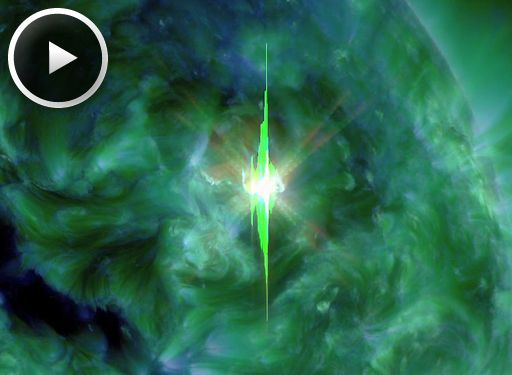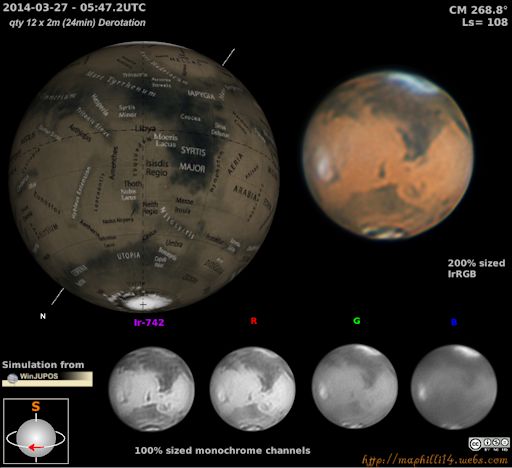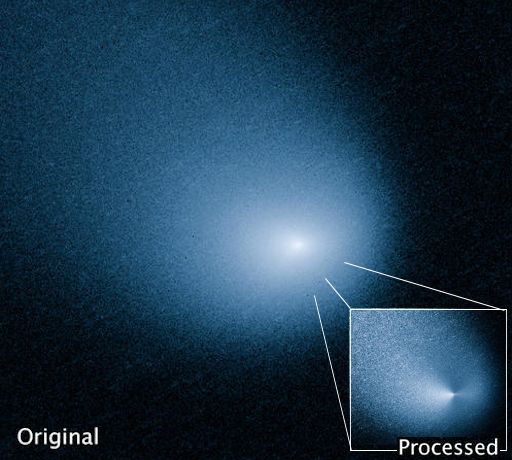Listen to radar echoes from satellites and meteors, live on listener-supported Space Weather Radio. | | |
CHANCE OF STORMS: Polar geomagnetic storms are possible on April 1st when one or more CMEs are expected to deliver glancing blows to Earth's magnetic field. The source of the incoming CMEs is active sunspot AR2017. High-latitude sky watchers should be alert for auroras. Aurora alerts: text, voice
SOLAR FLARE CAUSES RARE 'MAGNETIC CROCHET': On March 29th at 17:52 UT, the magnetic canopy of sunspot AR2017 erupted, producing a brief but intense X1-class solar flare. NASA's Solar Dynamics Observatory recorded the extreme ultraviolet flash:

Radiation from the flare caused a surge in the ionization of Earth's upper atmosphere--and this led to a rare magnetic crochet, measuring 17 nT at the magnetometer in Boulder, Colorado.
A magnetic crochet is a ripple in Earth's magnetic field caused by electrical currents flowing in air 60 km to 100 km above our heads. Unlike geomagnetic disturbances that arrive with CMEs days after a flare, a magnetic crochet occurs while the flare is in progress. They tend to occur during fast impulsive flares like this one.
The explosion also hurled a CME into space: movie. The bulk of the CME is sailing north of the sun-Earth line, but there appears to be a faint Earth-directed component that could deliver a glancing blow to our planet's magnetic field on April 1-2.
More flares are possible this weekend. NOAA forecasters estimate a 55% chance of M-class flares and a 20% chance of X-class flares on March 30th. Solar flare alerts: text, voice
Realtime Space Weather Photo Gallery
OPPOSITION OF MARS: Earth and Mars are converging for a close encounter in April. It's only March, but the view through backyard telescopes is already superb. Michael A. Phillips of Swift Creek, NC, took this picture using a 14-inch telescope on March 27:

In Phillips's picture, south is up. It shows the rapidly evaporating North Polar Cap (summer arrived in February), orographic clouds over martian volcanoes near the equator, and a bright blue cloud filling Hellas Basin in the south. Only an experienced astrophotographer can produce this kind of Hubblesque detail using backyard optics. Novice observers looking through the eyepiece of a small telescope can still see a lot, however, including the rusty-red disk of Mars and bright smudges corresponding to the polar cap and Hellas Basin.
The view will improve in April. Get ready to see the Red Planet at its best as explained in "The Opposition of Mars" from Science@NASA.
Realtime Mars Photo Gallery
HUBBLE SEES JETS IN MARS COMET: Later this year, Mars is going to have a close encounter with a comet. On Oct. 19, 2014, Comet Siding Spring (C/2013 A1) will buzz the Red Planet about 10 times closer than any known comet has ever flown past Earth. Mars could actually find itself inside the comet's extended atmosphere as the comet passes by only 138,000 km away. Needless to say, NASA is watching carefully. The latest images from the Hubble Space Telescope show jets spewing from the comet's core:

The image, captured on March 11th, shows comet Siding Spring at a distance of 353 million miles from Earth. Hubble can't see the icy nucleus because it is hidden inside the comet's glowing dusty atmosphere. Nevertheless, image processing did reveal what appears to be two jets of dust coming off the nucleus in opposite directions. This observation allows astronomers to calculate the direction of the nucleus's pole, and axis of rotation.
"This is critical information that we need to determine whether, and to what degree, dust grains in the [atmosphere] of the comet will impact Mars and spacecraft orbiting Mars," says Jian-Yang Li of the Planetary Science Institute in Tucson, Arizona.
Indeed, meteoroids from the comet could hit NASA's Mars orbiters and damage them even as the orbiters try to study the comet. The level of risk won't be known for months, but NASA is already evaluating possible precautionary measures. Data from Hubble and other observatories in the months ahead will clarify the dangers. Stay tuned for full coverage.
Realtime Comet Photo Gallery
Realtime Aurora Photo Gallery
Every night, a network of NASA all-sky cameras scans the skies above the United States for meteoritic fireballs. Automated software maintained by NASA's Meteoroid Environment Office calculates their orbits, velocity, penetration depth in Earth's atmosphere and many other characteristics. Daily results are presented here on Spaceweather.com.
On Mar. 30, 2014, the network reported 3 fireballs.
(3 sporadics)

In this diagram of the inner solar system, all of the fireball orbits intersect at a single point--Earth. The orbits are color-coded by velocity, from slow (red) to fast (blue). [Larger image] [movies]
Potentially Hazardous Asteroids (
PHAs) are space rocks larger than approximately 100m that can come closer to Earth than 0.05 AU. None of the known PHAs is on a collision course with our planet, although astronomers are finding
new ones all the time.
On March 30, 2014 there were potentially hazardous asteroids.
Notes: LD means "Lunar Distance." 1 LD = 384,401 km, the distance between Earth and the Moon. 1 LD also equals 0.00256 AU. MAG is the visual magnitude of the asteroid on the date of closest approach. | | The official U.S. government space weather bureau |
| | The first place to look for information about sundogs, pillars, rainbows and related phenomena. |
| | Researchers call it a "Hubble for the sun." SDO is the most advanced solar observatory ever. |
| | 3D views of the sun from NASA's Solar and Terrestrial Relations Observatory |
| | Realtime and archival images of the Sun from SOHO. |
| | from the NOAA Space Environment Center |
| | the underlying science of space weather |

